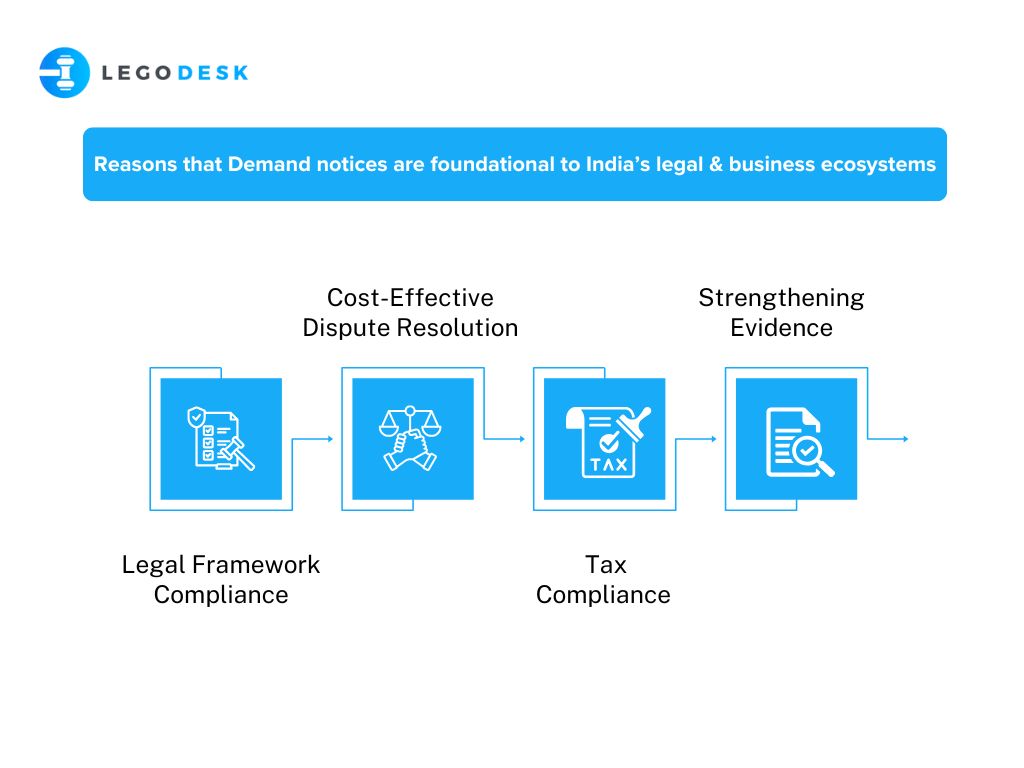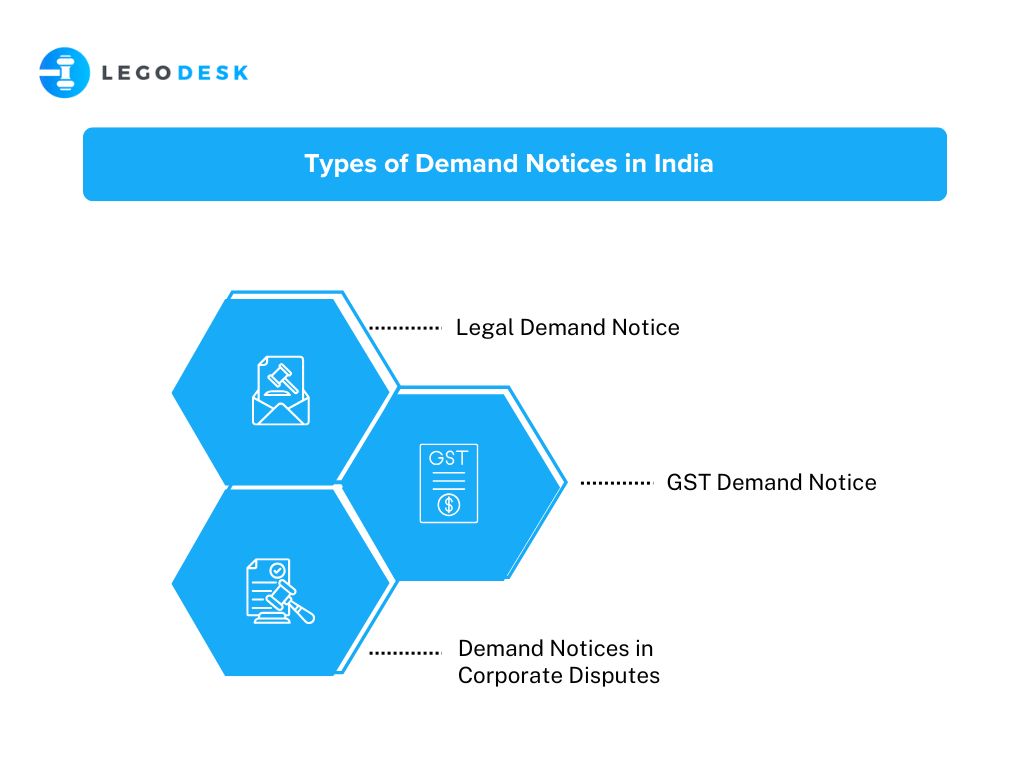What Is a Demand Notice? Understanding Its Format, GST Relevance, and Legal Implications in India
A demand notice is a formal communication issued to inform a person or entity of their legal obligation to fulfill specific duties, such as paying outstanding dues, rectifying a breach of contract, or adhering to tax compliance. In India, demand notices play a critical role in resolving disputes and ensuring compliance without escalating to litigation.
The purpose of a demand notice is twofold:
1. To formally notify the recipient about their obligation.
2. To offer an opportunity for the recipient to resolve the issue before legal proceedings commence.
This makes demand notices an indispensable tool in debt recovery, contract disputes, and tax compliance scenarios.
Importance of Demand Notices in India
Demand notices are foundational to India’s legal and business ecosystems for several reasons:

1. Legal Framework Compliance: In many cases, Indian law mandates issuing a demand notice before initiating legal proceedings, particularly in matters of debt recovery under laws like the Negotiable Instruments Act, 1881.
2. Cost-Effective Dispute Resolution: Demand notices provide an avenue to resolve disputes amicably without involving courts, saving time and resources for both parties.
3. Tax Compliance: Under the GST Act, tax authorities issue demand notices for unpaid taxes, ensuring proper adherence to financial laws.
4. Strengthening Evidence: A demand notice acts as evidence in court, showcasing the sender’s attempt to resolve the matter before escalating it to legal proceedings.
Key Elements of a Demand Notice
A demand notice must include the following essential components to ensure its validity and effectiveness:
1. Details of the Parties: Full names, addresses, and contact details of the sender and recipient.
2. Subject Line: A concise statement summarizing the purpose of the notice, e.g., “Legal Demand Notice for Breach of Contract.”
3. Chronology of Events: A detailed explanation of the events leading to the issue.
4. Legal Grounds: References to relevant contractual clauses or laws being violated.
5. Demand for Action: A clear statement of what the sender expects from the recipient, such as payment or adherence to a contractual obligation.
6. Timeline for Compliance: A reasonable time frame for the recipient to respond or comply, usually ranging from 7 to 30 days.
7. Consequences of Non-Compliance: A warning about potential legal actions if the issue is not resolved.
Types of Demand Notices in India

1. Legal Demand Notice
A legal demand notice is commonly used to resolve disputes involving unpaid debts, breach of contract, tenancy issues, or consumer complaints. For example, under Section 138 of the Negotiable Instruments Act, a demand notice must be issued if a cheque bounces, providing the recipient 15 days to repay the amount before further legal action.
2. GST Demand Notice
In the context of India’s Goods and Services Tax (GST) regime, authorities issue demand notices when a taxpayer fails to pay or short-pays the tax due. A GST demand notice specifies the amount owed, interest, and penalties, offering the taxpayer an opportunity to respond or rectify the issue.
#3. Demand Notices in Corporate Disputes
Corporates often issue demand notices for contract breaches, such as delayed deliveries, payment defaults, or non-compliance with agreed terms. For instance, a supplier may issue a demand notice to a buyer for unpaid invoices.
Demand Notice Format
A typical demand notice format includes:
1. Header:
– Sender’s details, including name, address, and contact information.
– Date of issuance.
2. Subject Line:
– E.g., “Demand Notice for Recovery of Outstanding Dues.”
3. Body:
– Introduction: Identify the sender and the relationship with the recipient.
– Chronology of Facts: A detailed account of events leading to the issue.
– Legal References: Relevant laws or contract clauses supporting the claim.
– Action Required: Specify the exact action expected, such as payment or compliance.
– Time Frame: Mention the deadline for response or compliance.
– Consequences: Outline potential actions if the demand is ignored.
4. Closing:
– Sender’s signature and contact details.
GST Demand Notice: A Closer Look
A GST demand notice is issued under Sections 73 and 74 of the CGST Act when authorities find discrepancies in tax payments.
Common Reasons for GST Demand Notices:
1. Incorrect tax calculations or classifications.
2. Delayed tax payments.
3. Input tax credit claims that are ineligible or fraudulent.
Steps to Handle a GST Demand Notice:
1. Review the Notice: Verify the authenticity and details of the demand.
2. Consult a Tax Expert: Seek professional advice to understand the implications.
3. Respond Within the Deadline: Provide explanations or rectify errors promptly to avoid penalties.
4. Appeal if Necessary: If you believe the notice is unjustified, file an appeal under GST rules.
Responding to a Demand Notice
Timely and appropriate responses to a demand notice can prevent unnecessary legal battles. Here’s how to handle one:
1. Understand the Issue: Carefully read the notice to grasp the claims being made.
2. Seek Legal Assistance: Engage a lawyer or expert to assess the notice’s validity and prepare a response.
3. Acknowledge Receipt: Inform the sender that you’ve received the notice and are reviewing it.
4. Negotiate: If possible, attempt to resolve the issue amicably without escalating to litigation.
5. Prepare for Legal Action: If resolution fails, be ready to defend your case in court.
Legal Implications of Ignoring a Demand Notice
Failing to respond to or act on a demand notice can have serious repercussions:
– Escalation to Court: The sender may initiate legal proceedings, which could result in significant financial and reputational damage.
– Additional Penalties: Non-compliance with GST demand notices, for instance, can attract hefty fines and interest.
– Weakened Legal Standing: Ignoring a notice demonstrates bad faith and may harm your position in court.
Examples of Demand Notices
1. Cheque Bounce Case:
A creditor sends a demand notice to a debtor after a cheque bounces, requesting payment within 15 days under Section 138 of the Negotiable Instruments Act.
2. Landlord-Tenant Dispute:
A landlord issues a demand notice to a tenant for unpaid rent or violation of lease terms, specifying a timeline for resolution.
3. Corporate Contract Breach:
A company sends a demand notice to a vendor for failure to deliver goods on time, citing relevant clauses in the contract.
Conclusion
Demand notices are vital tools in India’s legal, financial, and business frameworks. Whether it’s a legal demand notice for contract disputes or a GST demand notice for tax compliance, understanding their importance, format, and implications can save time, money, and unnecessary litigation. Responding appropriately and within deadlines not only resolves disputes amicably but also strengthens your legal standing. As a preventive and resolution-oriented measure, demand notices ensure fairness and compliance in the Indian legal system.
